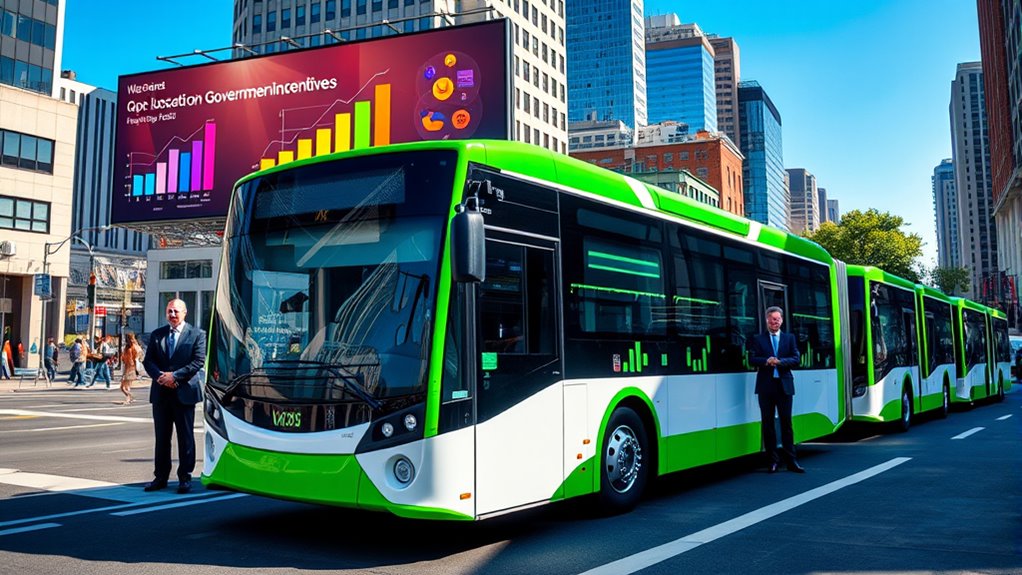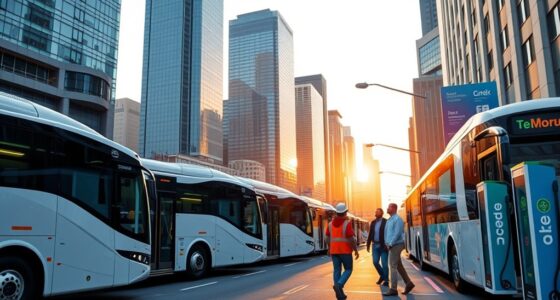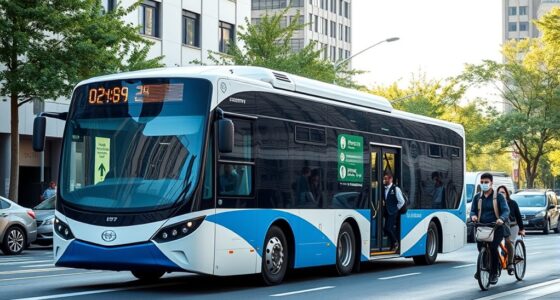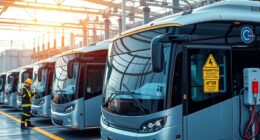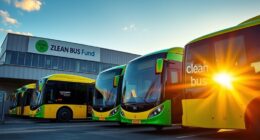Government incentives make buying electric buses more affordable by offering grants, rebates, tax credits, and low-interest loans. Federal programs from agencies like the EPA and FTA help cover purchase costs and infrastructure needs, especially for disadvantaged areas. Eligibility depends on vehicle type, ownership, and community status, with application processes often requiring documentation. These incentives not only cut costs but also boost job growth and industry development—discover more ways these programs support your clean transportation goals.
Key Takeaways
- Federal programs like FTA grants and EPA’s Clean School Bus Program provide financial support for electric bus purchases and infrastructure.
- State and local incentives, including rebates, vouchers, and tax credits, help offset initial costs for electric bus procurement.
- Funding opportunities prioritize disadvantaged, rural, and tribal communities to promote equitable access to electric bus benefits.
- Grants and low-interest loans assist in developing charging infrastructure, reducing operational expenses and supporting fleet transitions.
- Long-term incentives aim to lower total ownership costs through energy savings, maintenance reductions, and environmental benefits.
Overview of Federal Funding Opportunities
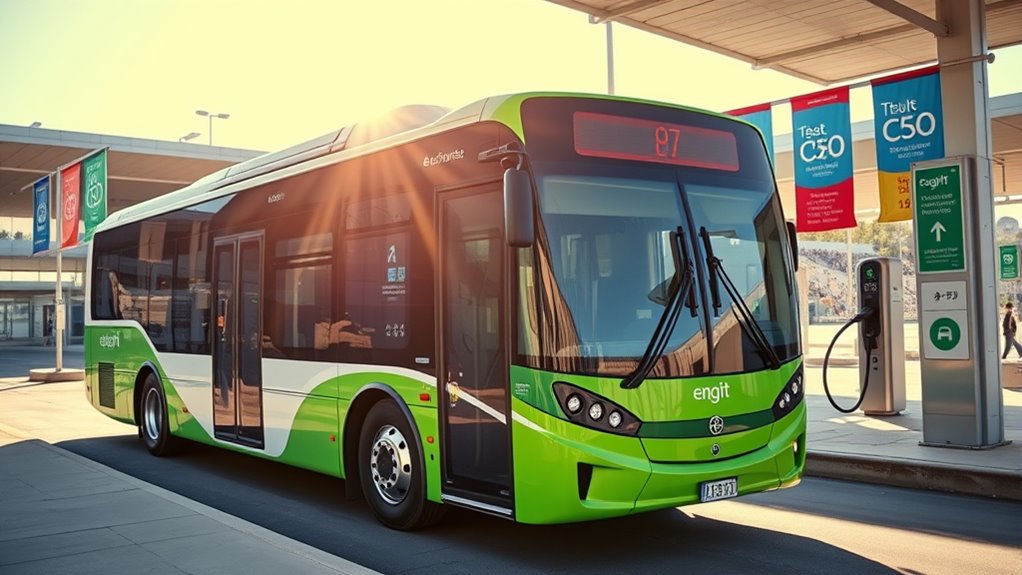
Federal funding programs play a crucial role in supporting the adoption of electric buses across the United States. The Federal Transit Administration (FTA) offers grants to buy buses and upgrade facilities, encouraging new propulsion technologies like electric models. Louisiana alimony laws outline the types of support available and the factors influencing awards, which can inform planning for funded projects. These programs often require detailed project management to ensure successful implementation and compliance with federal guidelines. Effective funding management is essential to maximize the impact of available resources and maintain transparency throughout the process.
The EPA’s Clean School Bus Program provides funding specifically for zero-emission school buses, with grants up to $325,000 per bus for priority districts. The Bipartisan Infrastructure Law (BIL) allocates funds for electric vehicle infrastructure, benefiting both public and school buses. Additionally, the USDOT offers grants for charging stations, making it easier to deploy electric fleets.
Eligible recipients include states, local governments, and Indian tribes, ensuring widespread access to funding opportunities. These programs collectively aim to accelerate the transition to cleaner, more sustainable transportation options nationwide. Efficient General Ledger Coding can help agencies manage the increased funding effectively and ensure compliance with reporting requirements.
Types of Incentive Programs Available
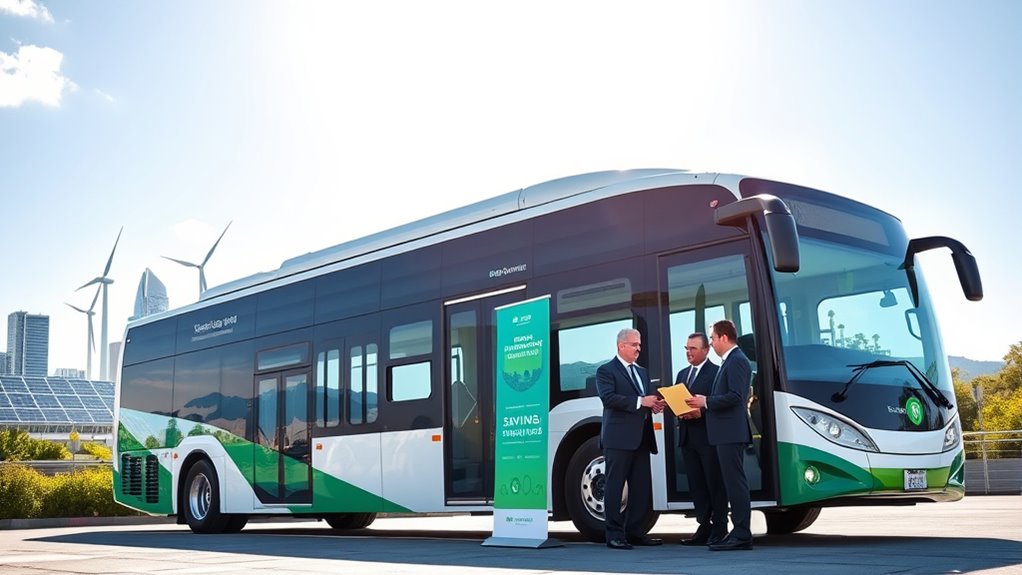
A variety of incentive programs are available to help offset the costs of purchasing electric buses. Government grants, like those from the EPA’s Clean School Bus Program, support eligible entities such as schools and public agencies, with award amounts varying based on environmental goals and need.
Rebate programs, including EPA rebates and utility provider discounts, offer cash back or price reductions—some programs, like the Central Coast Community Energy initiative, provide rebates up to $400,000. Additionally, program eligibility requirements are essential for successfully applying and qualifying for these rebates.
Voucher programs give immediate discounts on purchase prices, often on a first-come basis, targeting public schools and districts. Understanding administrative procedures involved in applying for these incentives can streamline the process.
Tax incentives reduce the initial investment through tax breaks, making electric buses more affordable.
Additionally, special financing options like low-interest loans, sometimes in partnership with private lenders, help spread costs and promote long-term savings. Recognizing regulatory compliance requirements is crucial for accessing these incentives and ensuring eligibility.
Eligibility Criteria and Application Process

To qualify for electric bus incentives, you need to meet specific eligibility criteria and follow a defined application process. First, confirm your vehicle qualifies as a Class 3-8 Battery Electric Vehicle (BEV) or Fuel Cell Electric Vehicle (FCEV). Eligible applicants include public school districts in New York State and third-party operators under contract with them. You’ll need to provide documentation proving ownership and operational eligibility, such as vehicle usage reports and ownership papers. Complete detailed application forms outlining your purchase or lease, and be prepared to share vehicle usage data. Many programs prioritize disadvantaged communities, low-income areas, rural regions, and tribal lands. Funding is often disbursed as vouchers covering a significant part of the incremental cost, making proper documentation and reporting essential for success. Additionally, understanding catering and delivery trends can help organizations plan better logistics and service delivery strategies for transportation solutions. Ensuring compliance with regulatory requirements related to vehicle emissions and safety standards is also critical for eligibility. Proper record-keeping and ongoing reporting are essential components to maintain eligibility and access continued funding. Incorporating compliance monitoring practices can further enhance your chances of sustained support and successful program participation.
Financial Benefits and Cost Savings
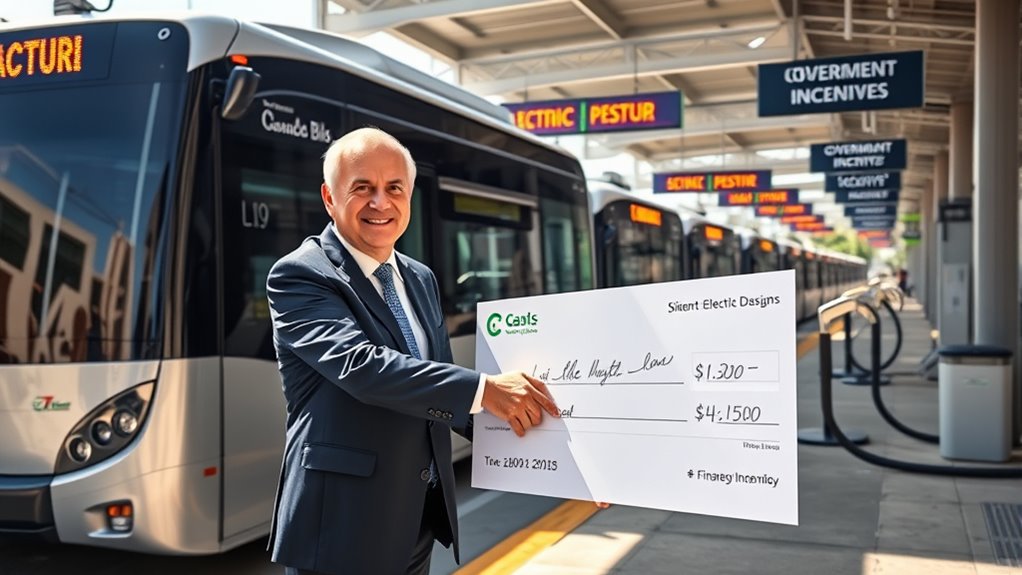
Taking advantage of financial incentives and cost-saving opportunities can substantially reduce the overall expense of shifting to electric buses. Tax credits, like the Qualified Commercial Clean Vehicle Credit, can provide up to $40,000 per bus, while grant programs from the Federal Transit Administration help offset purchase and rehabilitation costs.
Subsidies often cover a significant portion of the vehicle price, making electric buses more affordable. Additionally, incentives support charging infrastructure development through grants and tax credits, lowering setup costs. Proper planning for charging stations and vehicle deployment is essential to maximize these benefits and ensure efficient operation.
Investing in electric vehicle technology can further enhance long-term savings and operational efficiency. Operating costs are also lower, thanks to reduced fuel expenses, less maintenance, and access to discounted electricity rates. Over time, these savings, combined with government support, make electric buses a financially viable, long-term investment, helping you cut costs while advancing sustainability goals. Proper equipment setup and planning are crucial for maximizing these benefits and ensuring a smooth transition to electric bus fleets.
Impact on Job Creation and Market Growth
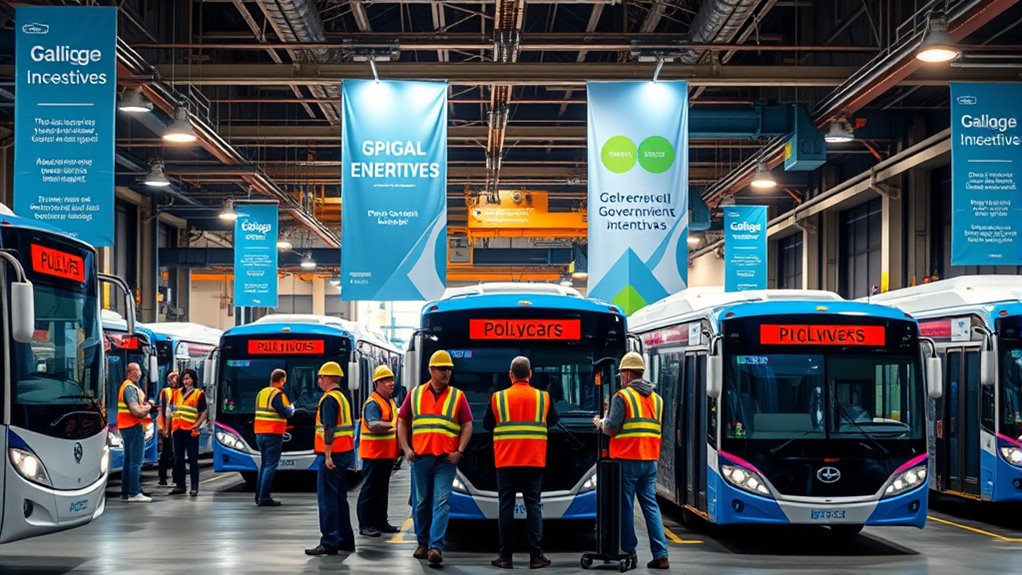
The rapid growth of the electric bus market is driven by significant investments at federal and state levels, leading to a remarkable increase in job opportunities. You’ll see a projected 26.8% CAGR in North America’s electric bus sector from 2020–2025, creating thousands of jobs.
Every $1 million invested in battery-electric bus manufacturing and charging infrastructure generates about 5.7 jobs. Over five years, more than 144,000 EV-related jobs have been announced across 28 states, with total investments surpassing $188 billion since 2014. Regional manufacturing hubs and other service sector resources support the broader economic ecosystem that benefits from this industry expansion.
Regional manufacturing hubs, like Hyundai’s Georgia facility and Scout Motors’ South Carolina plant, are expanding employment. These investments prioritize unionized jobs with better wages, while training programs and federal policies boost workforce development, fueling both market growth and job creation across the country. The development of electric vehicle supply chains plays a crucial role in sustaining this momentum and ensuring long-term industry stability. Additionally, fostering piercing care and hygiene practices among workers involved in manufacturing can contribute to a healthier workforce and reduce injury-related disruptions.
Advancements in Electric Bus Technology
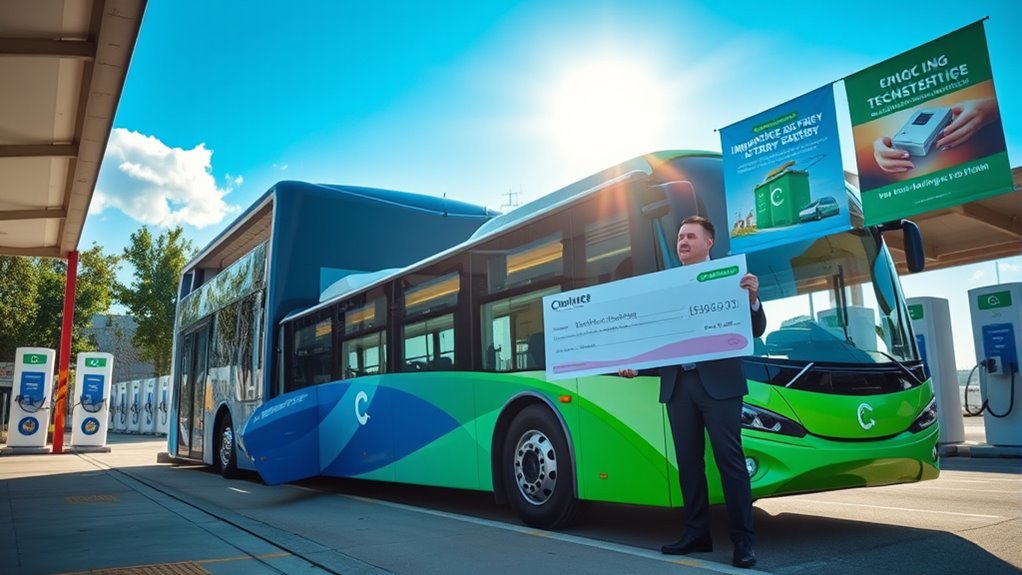
Advancements in electric bus technology have revolutionized transit systems by integrating cutting-edge innovations in drivetrains, connectivity, and energy options. You now benefit from buses equipped with advanced drivetrain concepts, including new e-machines that boost power and efficiency.
Multiple energy solutions, such as batteries, hydrogen fuel cells, and hybrids, offer flexibility to meet various operational needs. Manufacturing improvements by companies like Scania have enhanced battery capacity, charging systems, and motor performance, enabling longer routes and faster turnaround times.
Faster charging solutions up to 350 kW and improved infrastructure support quick recharges, keeping buses on the move. Globally, deployment is expanding beyond China, reflecting the widespread adoption of these technological innovations, which continue to make electric buses more reliable, efficient, and adaptable for diverse transit environments.
Supporting Infrastructure Development
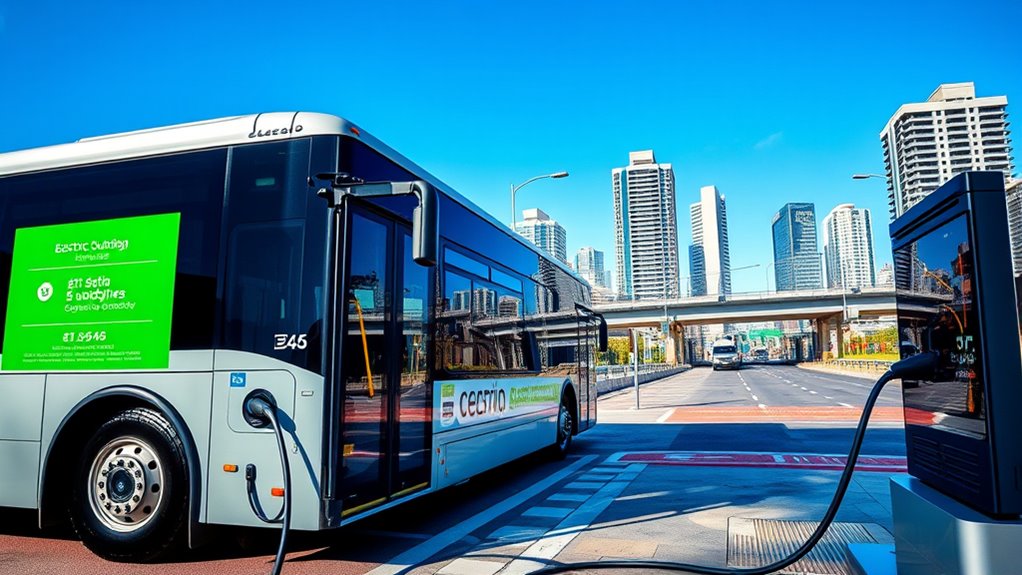
Supporting infrastructure development is essential for the widespread adoption of electric buses, as it guarantees reliable and efficient charging capabilities. You can access federal grants like the Buses and Bus Facilities Program, which fund charging stations and related infrastructure. State programs, such as Minnesota’s grants, further support the installation of charging stations. Governments also reduce electricity rates for charging, lowering operational costs. Public-private partnerships help finance infrastructure projects, making deployment more feasible. Innovations like rapid and high-power charging systems, along with solar-powered solutions, enhance efficiency and sustainability. Infrastructure planning now emphasizes grid integration, ensuring the energy system can handle increased demand. Proper development addresses land use and standards, facilitating accessible, environmentally responsible charging options for electric bus fleets. Additionally, leveraging WordPress security features ensures that infrastructure management platforms remain protected against cyber threats, safeguarding critical operational data. Furthermore, incorporating renewable energy sources into the charging infrastructure can significantly reduce the environmental footprint of electric bus operations. Exploring smart grid technology can optimize energy distribution and improve overall system resilience.
Policy Framework and Regulatory Support
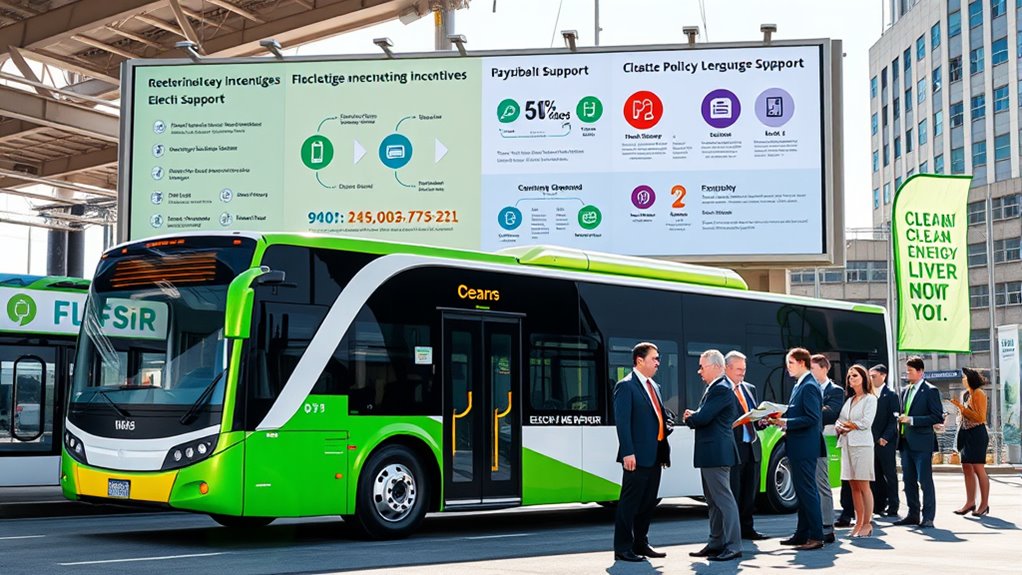
Policy frameworks and regulatory support play a crucial role in accelerating the adoption of electric buses by creating clear incentives and standards. Governments establish grant and incentive programs to help offset initial purchase costs, making electric buses more affordable.
Regulatory mandates, such as zero-emission vehicle requirements, push transit agencies toward electric options. Competitive tenders and green procurement prioritize environmentally friendly vehicles, encouraging market competition and innovation.
Dedicated funding ensures resources are available specifically for clean transportation projects. Regulatory measures like clear eligibility criteria, subsidy structures, and clean air laws ensure that incentives target the right projects.
Collaborative initiatives with local agencies further streamline adoption, helping you meet environmental goals while fostering a sustainable transit ecosystem. Incorporating renewable energy solutions like solar and wind can further enhance the sustainability of electric bus fleets and reduce overall carbon emissions.
Long-Term Benefits of Incentivized Adoption
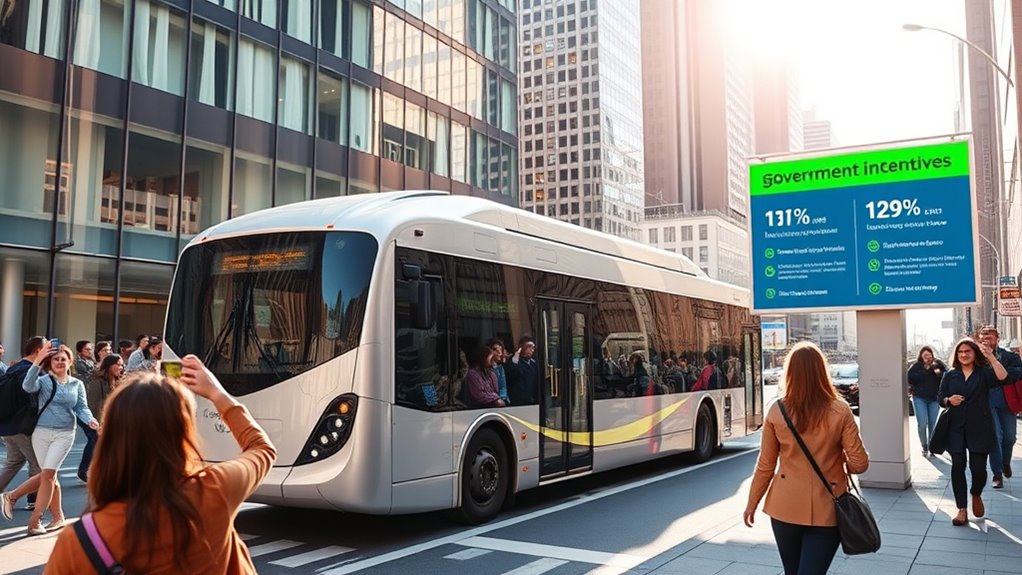
Long-term incentives for electric bus adoption deliver significant environmental, economic, and operational benefits that extend beyond initial investments. You’ll see a notable reduction in greenhouse gas emissions and harmful pollutants, leading to cleaner air and better urban living conditions.
Electric buses operate more quietly, reducing noise pollution and enhancing city environments. Operational costs drop thanks to lower energy expenses, less maintenance, and regenerative braking technology that extends battery life.
You’ll experience smoother rides with faster acceleration and improved safety features. Over time, the total cost of ownership decreases, offering long-term savings for fleets.
Plus, incentivizing electric buses stimulates local economies and creates jobs in manufacturing and maintenance. These benefits demonstrate that investing in electric buses isn’t just good for the environment but also financially advantageous in the long run.
Frequently Asked Questions
How Do Incentives Vary Between Different States and Localities?
You’ll notice that incentives differ across states and localities based on available funding and priorities. Some states, like California and New York, offer substantial grants and vouchers, while others focus on tax credits or rebates.
Local governments may provide additional perks such as grants, tax abatements, or access benefits. These variations reflect regional needs and resources, so you should check your area’s specific programs to maximize support for electric buses.
Are There Specific Deadlines for Applying for Government Electric Bus Grants?
You’re wondering if there are specific deadlines for applying for government electric bus grants. The current application period for the 2024 Clean School Bus Program ran from September 26, 2024, to January 14, 2025, with the deadline extended to January 14 at 4 PM ET.
Make sure to check for any future funding rounds, as deadlines can vary, and timely applications are vital for eligibility.
Can Private Companies or Non-Transport Organizations Qualify for Incentives?
While many incentives focus on public transit, private companies and non-transport organizations can indeed qualify. You’ll find tax credits, rebates, and grants available, especially if your project aligns with clean energy goals.
Programs like the Inflation Reduction Act expand eligibility, and partnerships with public agencies can open additional funding.
Leasing options and low-interest loans further support your shift to electric buses, making it more feasible to adopt sustainable transportation solutions.
What Documentation Is Required to Prove Compliance With Incentive Programs?
To prove compliance with incentive programs, you need to gather specific documents. You should provide vehicle ownership records showing you own the bus free of liens, DMV registration records from the past 24 months, and current safety certifications like CHP Form 292.
Additionally, include proof of insurance, mileage documentation, a detailed project budget, and supporting drawings of charging infrastructure. These guarantee your project meets all program requirements.
How Do Incentives Support the Transition to Zero-Emission Public Transit?
Incentives dramatically accelerate your shift to zero-emission transit, transforming the entire landscape of public transportation. They slash upfront costs, making electric buses irresistibly affordable.
They also provide substantial operational savings through reduced energy and maintenance expenses. With generous subsidies, grants, and tax credits, you can deploy cleaner, greener fleets faster than ever imagined.
These incentives turn the ambitious goal of sustainable transit into an achievable reality, fueling change at an unprecedented pace.
Conclusion
By taking advantage of government incentives, you can accelerate your shift to electric buses, much like a catalyst sparks a chain reaction. These programs not only reduce your upfront costs but also contribute to a cleaner environment, job growth, and technological innovation. Embracing these opportunities positions you at the forefront of sustainable transportation, ensuring your fleet stays competitive and future-proof. Don’t wait—seize the benefits today and drive your impact forward.
